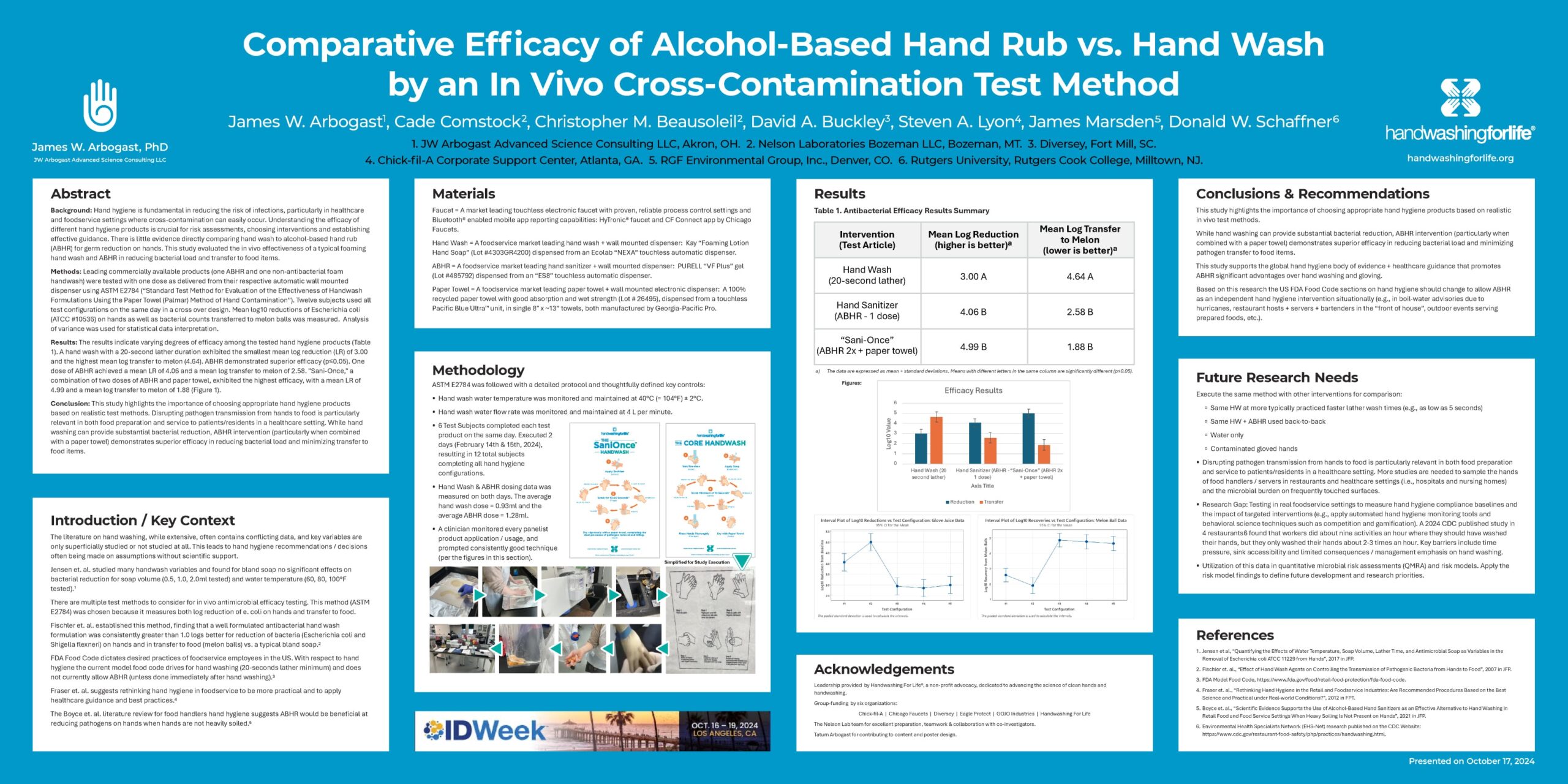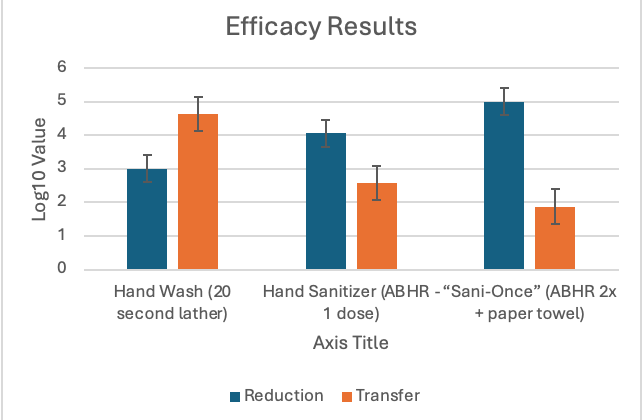
Research poster presented at IDweek 2024.
Introduction:
- The literature on hand washing, while extensive, often contains conflicting data, and key variables are only superficially studied or not studied at all. This leads to hand hygiene recommendations/decisions often being made on assumptions without scientific support.
- Jensen et. al. studied many handwash variables and found for bland soap no significant effects on bacterial reduction for soap volume (0.5, 1.0, 2.0ml tested) and water temperature (60, 80, 100°F tested).1
- There are multiple test methods to consider for in vivo antimicrobial efficacy testing. This method (ASTM E2784) was chosen because it measures both log reduction of e. coli on hands and transfer to food.
- Fischler et. al. established this method, finding that a well-formulated antibacterial hand wash formulation was consistently greater than 1.0 logs better for reduction of bacteria (Escherichia coli and Shigella flexneri) on hands and in transfer to food (melon balls) vs. a typical bland soap.2
- FDA Food Code dictates desired practices of foodservice employees in the US. With respect to hand hygiene the current model food code drives for hand washing (20-second lather minimum) and does not currently allow ABHR (unless done immediately after hand washing).3
- Fraser et. al. suggests rethinking hand hygiene in foodservice to be more practical and to apply healthcare guidance and best practices.4
- The Boyce et. al. literature review for food handlers hand hygiene suggests ABHR would be beneficial at reducing pathogens on hands when hands are not heavily soiled.5
Materials:
- Faucet = A market-leading touchless electronic faucet with proven, reliable process control settings and Bluetooth® enabled mobile app reporting capabilities: HyTronic® faucet and CF Connect app by Chicago Faucets.
- Hand Wash = A foodservice market leading hand wash + wall-mounted dispenser: Kay “Foaming Lotion Hand Soap” (Lot #4303GR4200) dispensed from an Ecolab “NEXA” touchless automatic dispenser.
- ABHR = A foodservice market leading hand sanitizer + wall-mounted dispenser: PURELL “VF Plus” gel (Lot #485792) dispensed from an “ES8” touchless automatic dispenser.
- Paper Towel = A foodservice market leading paper towel + wall-mounted dispenser: “Pacific Blue Ultra 8” high-capacity recycled paper towel roll (Lot #485792, 8 by ~13 inches per towel) dispensed from an “GP Pro” touchless automatic dispenser.
Methods:
ASTM E2784 was followed with a detailed protocol and thoughtfully defined key controls:
- Hand wash water temperature was monitored and maintained at 40°C (= 104°F) ± 2°C.
- Hand wash water flow rate was monitored and maintained at 4 L per minute.
- 6 Test Subjects completed each test product on the same day. Executed 2 days (February 14th & 15th, 2024), resulting in 12 total subjects completing all hand hygiene configurations.
- Hand Wash & ABHR dosing data was measured on both days. The average hand wash dose = 0.93ml and the average ABHR dose = 1.28ml.
- A clinician monitored every panelist product application/usage, and prompted consistently good technique (per the figures in this section).
Conclusions & Recommendations:
- This study highlights the importance of choosing appropriate hand hygiene products based on realistic in vivo test methods.
- While hand washing can provide substantial bacterial reduction, ABHR intervention (particularly when combined with a paper towel) demonstrates superior efficacy in reducing bacterial load and minimizing pathogen transfer to food items.
- This study supports the global hand hygiene body of evidence + healthcare guidance that promotes ABHR significant advantages over hand washing and gloving.
- Based on this research the US FDA Food Code sections on hand hygiene should change to allow ABHR as an independent hand hygiene intervention situationally (e.g., in boil-water advisories due to hurricanes, restaurant hosts + servers + bartenders in the “front of house”, outdoor events serving prepared foods, etc.).
Future Research Needs:
Execute the same method with other interventions for comparison:
- Same HW at more typically practiced faster lather wash times (e.g., as low as 5 seconds)
- Same HW + ABHR used back-to-back
- Water only
- Contaminated gloved hands
- Disrupting pathogen transmission from hands to food is particularly relevant in both food preparation and service to patients/residents in a healthcare setting. More studies are needed to sample the hands of food handlers/servers in restaurants and healthcare settings (i.e., hospitals and nursing homes) and the microbial burden on frequently touched surfaces.
- Research Gap: Testing in real foodservice settings to measure hand hygiene compliance baselines and the impact of targeted interventions (e.g., apply automated hand hygiene monitoring tools and behavioral science techniques such as competition and gamification). A 2024 CDC-published study in 4 restaurants6 found that workers did about nine activities an hour where they should have washed their hands, but they only washed their hands about 2-3 times an hour. Key barriers include time pressure, sink accessibility, and limited consequences/management emphasis on hand washing.
- Utilization of this data in quantitative microbial risk assessments (QMRA) and risk models. Apply the risk model findings to define future development and research priorities.
Acknowledgments: Exactly what you had in the last poster + one more point:
- Brad Simpson and Tatum Arbogast for contributing to content and poster design.
References:
- Jensen et al, “Quantifying the Effects of Water Temperature, Soap Volume, Lather Time, and Antimicrobial Soap as Variables in the Removal of Escherichia coli ATCC 11229 from Hands”, 2017 in JFP.
- Fischler et. al., “Effect of Hand Wash Agents on Controlling the Transmission of Pathogenic Bacteria from Hands to Food”, 2007 in JFP.
- FDA Model Food Code, https://www.fda.gov/food/retail-food-protection/fda-food-code.
- Fraser et. al., “Rethinking Hand Hygiene in the Retail and Foodservice Industries: Are Recommended Procedures Based on the Best Science and Practical under Real-world Conditions?”, 2012 in FPT.
- Boyce et. al., “Scientific Evidence Supports the Use of Alcohol-Based Hand Sanitizers as an Effective Alternative to Hand Washing in Retail Food and Food Service Settings When Heavy Soiling Is Not Present on Hands”, 2021 in JFP.
- Environmental Health Specialists Network (EHS-Net) research published on the CDC Website: https://www.cdc.gov/restaurant-food-safety/php/practices/handwashing.html.


